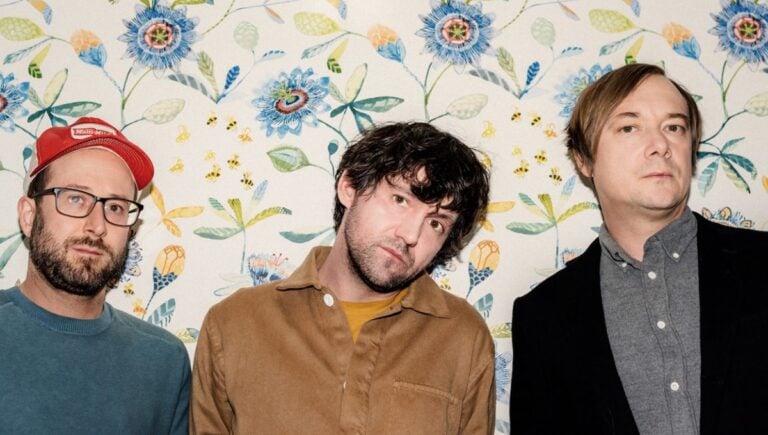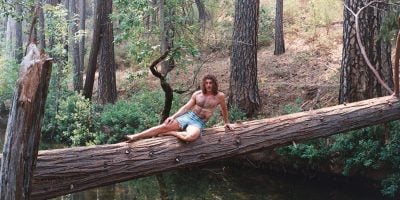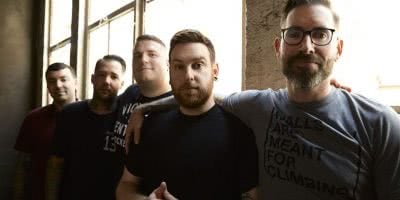Bright Eyes are about to begin a long-awaited tour of Australia and New Zealand, taking in ten stops across the two countries between October and November, including an appearance at Harvest Rock II.
And when we say “long-awaited”, we mean it: one of the seminal indie rock bands of their generation haven’t toured in these parts in a very long time, with Bright Eyes’ last Aotearoa show taking place 18 years ago. (‘For The First Time In Forever’ the tour is appropriately titled.)
There was method behind the absence, with being on hiatus for most of the 2010s; upon their return, Conor Oberst and his band’s comeback was cruelly curtailed by the pandemic.
But through it all, Bright Eyes’ thoughtful and affecting music has endured, and there haven’t been many more distinctive songwriters in indie rock than Oberst over the last three decades.
Now, Conor Oberst, Mike Mogis, and Nate Walcott are ready to reward Australian and Kiwi fans for their patience with “a celebration of the decades-ranging Bright Eyes canon”, from early material to fan favourites, covers to recent releases.
To celebrate the impending tour, Tone Deaf asked Oberst to discuss the history of each Bright Eyes’ album, including their resolutely raw debut album, the unanimously acclaimed record that he didn’t expect to be so popular, and the band’s 2020 comeback album.
Love Indie?
Get the latest Indie news, features, updates and giveaways straight to your inbox Learn more
As the title indicates, I recorded these songs when I was 15 to 17 on a quarter inch TEAC 4-track in my parents’ basement. It sounds terrible. The songs are pretty embarrassing for the most part. But what are you gonna do? I remember when it was originally released, it received one of the worst reviews I have ever read for any record. But we sold out of the initial pressing and had to repress the CDs. So we printed the whole review on the face of the CD of the second pressing. It was kind of a ‘fuck you’ to whatever stupid publication it was from, but also an acknowledgement that we knew things could get better; that we were capable of more and willing to laugh at ourselves.
Letting Off the Happiness (1998)
This was the first record that Mike Mogis was involved with from the start. It feels like our first “real” record. We recorded half of it in my parents’ basement and half in Athens, Georgia, at our great friend Andy LeMaster’s studio (Andy has been a lifelong Bright Eyes contributor). Making this record was exciting. I was 18 years old and hungry to make things that I felt were worth something. We had players from Athens bands like Neutral Milk Hotel and Of Montreal on there. Bands we loved. It felt like a big deal at the time. First time any national press wrote about us and our little Omaha, Nebraska, record label called Saddle Creek. It was weird and getting weirder.

Fevers and Mirrors (2000)
This was the first Bright Eyes record that felt like a complete thought. We recorded it in Mike’s basement in Lincoln, Nebraska in a particularly cold winter when I was 19. I felt like we found our own identity and we were making music no one else could make. Not that we were great musicians or enlightened in any way, just that no one else could make what we were making because it was coming from a very specific, original place.

Lifted or The Story Is in the Soil, Keep Your Ear to the Ground (2002)
This was by far our most ambitious record to date. Michael finally had a “real” studio in Lincoln called Presto! We still didn’t really have any money but we had a lot of talented friends and a lot of big ideas. I slept on the floor on an air mattress in the tracking room of the studio for months. Didn’t shower much. We had so many people roll through and contribute.
It was a makeshift mini orchestra and drum corp and choir but basically sixth grade level. We were stealing production ideas from heroes like Portishead, pressing test copies of individual tracks on vinyl and scoffing them up and playing them back into the tracks. Stuff like that. I was obsessed with Leonard Cohen’s “Death of a Ladies Man” at the time. Produced by Phil Spector. Mogis and I referenced that a lot while making this one.
I’m Wide Awake, It’s Morning (2005)
After Lifted and the following tour blew up, I needed to move out of Nebraska. At 23, I moved to New York City. It changed my life in innumerable ways but also resulted in writing all these songs about being a Midwest transplant in NYC in 2003 when American life felt really upside down. It is by far Bright Eyes‘s best-selling and most popular record. I honestly can’t tell you why. It doesn’t really sound like any of our other records. Maybe that’s why. A 1970’s inspired folk-rock record in 2004. Who knew?

Digital Ash in a Digital Urn (2005)
Wide Awake came together really quickly, it was recorded within a couple weeks. In contrast, Digital Ash took six months of meticulous editing and a lot of ambition. We were trying to push ourselves towards new sounds. Both records were released on the same day in 2005. We went on tour consecutively, first for Wide Awake and then Digital Ash, playing the respective records for each. With Wide Awake, we were met with a Beatles-esque reception. It was madness! And for Digital Ash, we were just completely received as traitors. It seemed to me that people wanted to kill us.

Cassadaga (2007)
After the dust cleared on the double release, we signed a record deal with Universal and suddenly we had more money than we ever thought possible. We built a studio in Omaha and embarked on our Magnum opus. On reflection, I think it succeeded and failed in equal measures. Even though he was involved unofficially before, it was the first record that solidified our future as a three-piece band: myself, Mike Mogis, and Nate Walcott. I’m proud of this record but thinking back, maybe we left it in the oven a little too long.

The People’s Key (2011)
Four years after the release of Cassadaga, we wanted to try our hand at something new. Cassadaga was an elaborate construction, so for The People’s Key, we opted for something pared down, simpler, modern. We thought we could make a record like The Killers. A hit! Turns out my lyrics are too weird and their melodies are too catchy. It wasn’t meant to be. But you know, we made the record we were meant to make, and I stand by that.

Down in the Weeds, Where the World One Was (2020)
It had been seven or eight years since The People’s Key came out. Mike, Nate, and I had kept busy with our own projects but it felt like the right time to bring it all back together. We thought about who to recruit. One of my favorite records is the Mars Volta’s De-Loused in the Comatorium – turns out the drummer and bass player is John Theodore (Queens of the Stone Age) and Flea (Red Hot Chili Peppers) and even though on paper that makes no sense, in our twisted minds it did.
So we all got together in Los Angeles and the project found its momentum. The pandemic derailed our release plans, but when we finally got to tour this record it was so special to play these songs for a live audience. We’re stoked to finally bring this album to the beautiful people of Australia.
Bright Eyes 2023 Australian/New Zealand Tour
Tickets available via lovepolice.com.au or livenation.co.nz
Tuesday, October 24th
Enmore Theatre, Sydney, NSW
Thursday, October 26th*
Northcote Theatre, Melbourne, VIC
Friday, October 27th*
Northcote Theatre, Melbourne, VIC
Sunday, October 29th
Harvest Rock II, Adelaide, SA
Tuesday, October 31st
Astor Theatre, Perth, WA
Thursday, November 2nd
Princess Theatre, Brisbane, QLD
Saturday, November 4th
Odeon Theatre, Hobart, TAS
Tuesday, November 7th
Powerstation, Auckland, NZ
Wednesday, November 8th
Ngaio Marsh Theatre, Christchurch, NZ
Thursday, November 9th
San Fran, Wellington, NZ
*With Warpaint



































